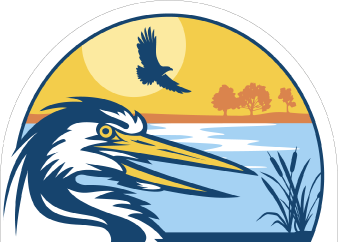
Who could not be captivated by the beautiful song and graceful flight of our largest swallow species, the Purple Martin? I for one, have long admired these glossy purplish-blue long-distance migrants to North America. I’ve also recognized how difficult it can be to attract Purple Martins to my own backyard, which is another story! You need only visit Iroquois National Wildlife Refuge and the surrounding New York State Wildlife Management Areas to learn more about martins and appreciate for yourself the immense effort the refuge staff and volunteers have made in helping to boost the numbers of local purple martins. Many years of hard work have been put in at Iroquois in support of martins using the most appropriate and beneficial housing.
I’d like to share with you exciting news on what will be happening at Iroquois once the martins return, in only a few short weeks, around April 10th. I’ve paraphrased below from material shared from SUNY at Buffalo’s Dr. Heather Williams on her upcoming study she titles: “Purple Martin First Flights”
Click here to become a member!
Click here to donate!
Over the past four years at Iroquois, Dr. Williams has studied purple martin body condition and fitness from the egg stage to fledging by observing in-nest activity with video cameras. You may have noticed the video camera associated wiring at the martin house and gourd rack at Iroquois Headquarters on Casey Road (Click here to see some of our nest video!). Dr Williams, her interns and the volunteers on the martin team collected data from five locations at the “swamps.” Dr. Williams, along with Dr. Robert DeLeon, has used trained Artificial Intelligence models to quantify adult incubation attentiveness and provisioning rates. Dr. Williams also investigated the effect of nest ecoparasites on nestling fledging rate and body mass, and used blood sampling to arrive at many conclusions, but simply put here, she found that the vast majority of nestlings make it to the fledging stage. Hooray! If you would like, dive into the details of her various papers, click here. Dr. Williams can also be reached at hw49@buffalo.edu for full copies of her papers.


This year, Dr. Williams will focus her research on the next life stage -juvenile migration- which from previous research is known to cause high mortality in purple martins. How do researchers study this life stage? New technologies in wildlife tracking are making it possible to monitor even small-bodied birds such as martins. Amazingly, tag transmitters are now light enough to be safely carried by small birds and have the battery life to transmit data for more than 1 year without the need to recapture the bird.

Last year, with support from the Friends of Iroquois, Inc., Iroquois NWR was able to install a Motus Wildlife Tracking System tower. Motus is an array of automated radio telemetry stations which can track movements of small animals. Locations of animals fitted with a tag transmitter are recorded whenever they are within range of a receiving station (https://motus.org/data/receiversMap). Making use of this tower in her 2021 study, Dr. Williams hopes to track martin fledglings on a continental basis at a relatively low cost, whenever they are within range of a receiving station. Relating back to her previous work on nestling body condition, she hopes to explain which juveniles are successful migrants and which fall by the wayside.

This study will also look at events in the breeding season that may have a carry-over effect on adult fall migration. Dr. Williams hypothesizes that adults that invest more effort into nestlings may have a delayed departure date. To collect this type of data, additional cameras were needed at Iroquois on the outside of our gourds. Retired Engineer and Iroquois Volunteer Carl Zenger designed and created a camera set-up to observe martin behavior on the porch section of a horizontal martin gourd. The cameras and their associated wiring will now access behavior of juveniles and adults on porches!

Another goal of the project is to better understand the localized movements of purple martin fledglings and adults around the breeding ground prior to fall migration. Knowing more about all the project aims will make a substantial contribution to help us better understand the purple martin, a native cavity nesting species of conservation concern.

Last month, the Purple Martin team attended a workshop led by Andrea Patterson, Master Bander, NABC Trainer, Board President of the Braddock Bay Bird Observatory. Andrea is a masterful instructor and came prepared to share with project leader Dr. Williams and the team her expertise in attaching Motus tags to conduct long range tracking of migratory birds. Andrea arrived with a cage containing several House Sparrows, which she captured with a mist net at an apartment complex near her home. (All the sparrows were returned alive to that location!) Those of us with various levels of banding training had the opportunity to practice putting tiny backpacks with tag transmitters on the House Sparrows. Speaking for myself, the hardest part was making sure the straps fit over the bird’s thigh. So many feathers in the way of seeing what was what! Confidence came with practice.

A bird can safely carry 3% of its body weight. Our fledging martins weigh an average of 50 grams and their tags will weigh just 0.9 grams plus the elastic, giving us peace of mind that we are well under welfare guidelines. All this telemetry equipment will of course cost money! The support for this purple martin project will come from the Friends of Iroquois NWR, Inc., the Buffalo Ornithological Society, the North American Bluebird Society, New York State Bluebird Society and the Purple Martin Conservation Association. Other tax-deductible contributions are welcome and can be made to FINWR, Inc. 1101 Casey Road, Basom, NY 14013, or at the FINWR.org website at shop.finwr.org with a note that they be designated toward purple martin research.

